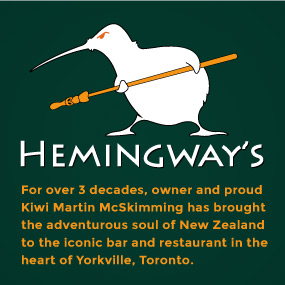So, that was Easter. What a buzz all round. The stone at the sepulchre door has been shifted, and an impossible calendar of commitments has been met. Last year sometime I agreed to help a young journo, Geoff Neems, who, with his mate Patrick, wanted to write a book about reggae and Rasta in New Zealand. I’d given Te Papa a public kick in the ribs a few years back when they mounted a show on the same theme. They had it right from about 1980 onwards, but they were Auckland-centric and missed, I believe, some of the defining aspects of reggae and Rasta as it grew and developed here in Aotearoa. I argued that the Keskidee Aroha Tour, planned from 1977 and realised in 1979, was probably the defining catalytic event and within it the seed bed of Pacific Reggae and, through Tigilau Ness, also of Rasta in Aotearoa. Anyway Geoff and Patrick agreed to at least listen to an alternative history than that propounded by ‘our place’, and, so, to tell the pre-1980 story I agreed to take Geoff to meet with some of the Rasta brethren from Ruatoria, Ngati Dread, and with some members of Te Rau Aroha a now disbanded Rasta community from Haumoana in Hawke’s Bay. I had a photo taken of the Te Rau Aroha crew at Te Haroto Marae in 1981. There were thirteen people in the group and I knew them like it was yesterday. It seemed like it would be easy enough to track them down. Not so. Four of them were dead, and it caused me to reflect on the high rate of death amongst this and similar cohorts. Of a local five member band of the same period, Otatara Rastafari, there is only one member left alive. In any case after all sorts of driving around Hastings and calling in on I tracked down Gerald Harris and Tama Kerika and through them remaining contacts.
In terms of the Ruatoria Rasta I thought it would be important to travel up the Coast and go and see John Heeney, the brother generally accepted as the leader, to see if he even wanted to talk to ‘Babylon’. So a few weeks back, when Taape had a weekend she didn’t have to work, we decided we’d grab the chance and combine a task with a bit of R&R, calling in to stay with her sister Hilda in Tikitiki. It was a laid back trip and we pulled into Rangitukia late on a Saturday afternoon. It didn’t take long for me to end up supping a few beers with Hilda’s hubby, Rick, and we all chatted away into a bright starlit Waiapu night.
Waiapu River
I talked with Rick about some work I wanted him to help me with, and Hilda told us about her plans for her little craft shop in Ruatoria. Brekky the next morning was home-raised home-cured bacon and free-range eggs and home-grown grapes from the vines along the fences.
Before departure we had hugs all round and I was pretty convinced that I’d talked Rick into coming down to the Bay with some of his fellow Ngati Porou Ahi Kaa MC bikers for the Hui & Huilli Irish Golf Tournament that I’d lined up for Paddy’s Day. Taape and I seldom get the chance to please ourselves about time, and with no looming deadlines or appointments on the way home we diverted over to Mahia to see John and Mary Coleman of ‘Hummingbird’ fame who were holidaying there. John caught two kingfish from his boat in the bay and it did not take long for the fish to be filleted and served up for kai, accompanied by a green salad full of piquant I-know-not-whats. The four of us sat on the deck content to the max, Darby and Joans, and watched the sun drop over the sea, a counter-intuitive experience on the East Coast. Taape and I were still feeling warm about the whole weekend experience during the entire following week, and I was keen on seeing Rick and Hilda on the coming Saturday, as they were due down for a school fair. On the agreed date I rang Rick a couple of times but his message system kept on kicking in. Another bro, John, rang from the Coast early on Saturday evening. “Bro, is Rick with you?” “No”. “Shit, then its bad news bro”. Rick had shot himself. The next 48 hours were a nightmare of confusion, guilt, and sadness. His sons arrived on their way from Wellington to Rangitukia. I began the rituals of grief as I greeted them. When I spoke to him all I could say was “Fuck you Rick”. Rick was one of three local Ruatoria district Maori to take their own life that weekend or thereabouts.
The people were confused. How do you grieve in such a circumstance? If you see the self-dead off with the emotion that you feel and with the traditional rituals and community support of tangihana do you actually popularise and promote suicide? At the prayers on the night before Rick’s burial the presiding churchman was in full critical and judgemental flight. It was, he intoned, the end of days. An avenging angel is on the way. His language was that of war with much taking up of arms and striking down of sinners. It sounded like Baghdad. And when he was done a young acolyte rose. And on he went, for about an hour, about my brother having let the devil in, and our use of booze, and the presence of gangs, and somehow the Government’s legalisation of prostitution came into it. But I was past listening and simply wanted to shove the King James version right up his self righteous arse. Mao Tse Tung used to encourage us to know our enemy. I had never considered my biblical and liturgical training in this light before but on that sad evening it was as if I had a quiver of arrows, sharpened arguments based on familiarity with biblical text. In my pissed-off state I was like a taut bow, and away I fired. Did not Christ hang around with thieves on the Mount called Galgotha? Was not Mary Magdalene, Christ’s friend, a prostitute? Did He not turn water into wine at Caenna so that the wedding guests could have a bloody good party? And, if He were to return to earth today as was being proposed, then was it not likely that He would be attacked again, not by gang members, the imprisoned and poor, but rather the same bastards that got Him last time, those with wealth and power, the priests and the hypocrites?
The following day the boys from Ngati Porou Ahi Kaa MC rode their Harleys up the impossible track to the urupa and we laid Rick next to his dad whilst his muso mates sang ‘from the west to the east, he will be released’. May that be so. Suicide is a shit of an occurrence and it is a route of action taken by about 500 Kiwis each year, a toll higher than that our road toll. Proportionately speaking its something that men choose (3:1) and Maori are also over-represented although affecting a slightly wider and older demographic than the mainstream. I’m pleased that leaders such as Jim Anderton who have been affected by suicide in their own families (Jim said recently that suicide is an event that a family can learn to live with but will never get over) have ensured a step up in our response to the problem.
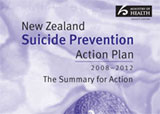
Suicides are actually tracking downward (by about 20% over recent years). The Ministry of Health has just published the ‘New Zealand Suicide Prevention Action Plan 2008-2012’. I commend it and its associated publications to you. In truth I can’t say that if I read it the night before I’d have been any use to Rick. But, as always, being informed is a good thing and the plan makes you aware of issues and aspects unlikely to be commonly known, provides good advice on what to do if encountering someone contemplating suicide, and equips you to best support and care for those who remain, hurting.
Right, so, a week in mourning blew the daily plans around a bit. I’ve been in overdrive anyway. In a fit of optimistic delusion I had volunteered to take a stint at the operational helm of CART, the Consultancy Advocacy and Research Trust in Wellington. I’ll come to that presently. I’d been relieved to receive confirmation from Unitec that I’d been awarded a Masters in Social Practice with 2nd class honours. I’ve enjoyed the journey. The need for life long learning is a reality in this age of uncertainty and at this man’s age. Encountering new and emergent epistemologies such as ‘Transdisciplinarity’ not only broadens horizons and gives deeper perspective but it challenges long held beliefs and certainties. Similarly subjecting yourself to the disciplines of academia, and jumping through the pedantic hoops set by examiners and academic administrators is as good for the intellect as it is for the soul. Thanks to all my lecturers and supervisors for their input and thanks to my whanau for their tolerance whilst I finished the dissertation. You can download the dissertation here if you want to check out my work.
I mentioned Wellington. On one hand the City is a danger to me …too many friends own too many bars….on the other it is stimulating and brings out the best in performance, like playing on number one ground. When I’m involved in meetings there they seem to be harder, faster, and set at a higher level of importance than I encounter elsewhere. Its all got to do with propinquity, those relationships that stem from the Beehive and influence what happens and how it happens in our little country. As I mentioned earlier I’d agreed to take over management of CART from my son Laurie whilst he was away supporting partner Monique who’s acting as a rural locum. In Wellington the CART team are joining in on a community development response to a number of issues on the social periphery. The effort is geographically concentrated on Newtown, Berhampore, Strathmore and the Central City. It is tackling things on a broad front, housing, whanau health, education, training, employment, relationships, recreation and criminal justice. There have been a few current issues, one a crew of young guys who have recently come on the scene. They are volatile, being right into some pro-social activity one minute then off on something heinous the next. In many ways, as we start on the long pathway to some point of stabilisation with them, the best we can do is to achieve a ‘least bad’ outcome. Another has been around some aggro between the Darksyders and some other local Polynesian youth called FBI, Full Blooded Islanders. The good thing is that thirty years or so of urban living have produced their own cross-cultural networks and we were able to get productive dialogue and agreement that all parties will step back. In the meantime the FBI leadership and their community leadership are working with the Police and with CART to scope the actual situation. It seems that many of the FBI are still at school, and so an obvious strategy is to keep them there. Its been good working with the local Commissioner for the Ministry of Social Development to build sustainable programmes to meet these challenges.
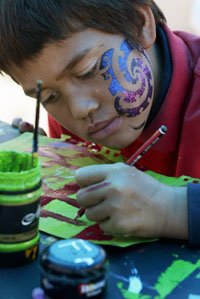
Indigenous artist - Courtesy of Hawke's Bay Today
People can go on about climate warming but what about the bloody trouble caused by the confluence of moveable feasts! This year St Paddy’s Day fell about a week out from Easter and I’d committed my whole crew at the Waiohiki Creative Arts Village not only to the Irish Maori St Patrick’s Day Hui & Huilli, with all of its potential to live out Murphy’s Law, but to an Easter Arts Market as well.
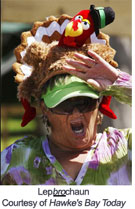 On the eve of Paddy’s Day we ran a Hui & Huilli “People’s Day” with a number of Celtic and Maori activities, moko face painting, Maori kite making, Irish dance, music and storytelling. The latter was the core activity, firstly with Mary Kippenburger providing interactive storytelling. Accompanied by a guitarist Mary strides out into the area in front of the stage with a huge bright pink suitcase full of props and costumes, and away she goes. Mary’s stage voice is strong and full with a sort of American TV drawl. First one story, then another. The kids start to congregate around her. The suitcase opens and a number of hats are produced: this one a chook head, another a set of elephant ears and trunk, a giraffe neck and head, a lion’s mane, and then Mary starts calling people forward and enrolling them in her story, a sort of jungle based morality play.
On the eve of Paddy’s Day we ran a Hui & Huilli “People’s Day” with a number of Celtic and Maori activities, moko face painting, Maori kite making, Irish dance, music and storytelling. The latter was the core activity, firstly with Mary Kippenburger providing interactive storytelling. Accompanied by a guitarist Mary strides out into the area in front of the stage with a huge bright pink suitcase full of props and costumes, and away she goes. Mary’s stage voice is strong and full with a sort of American TV drawl. First one story, then another. The kids start to congregate around her. The suitcase opens and a number of hats are produced: this one a chook head, another a set of elephant ears and trunk, a giraffe neck and head, a lion’s mane, and then Mary starts calling people forward and enrolling them in her story, a sort of jungle based morality play.
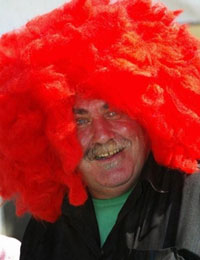
Orange, whiteman and green
And then its another – I end up as a red-haired hippy in some shaggy dog tale – and another, with some other poor mug corralled for mocking – and another, this one about princes and princesses and fairies and bad witches – and now there are about ten people, kids and adults, in the story all dressed up in sparkling gowns and flowing capes and unlikely hats, and those kids not actually in role are sitting there goggle eyed and completely engaged.
Have no fear about the loss of imagination through modern day computer-based toys. All is well in fantasy land, and storytelling and story listening seem as natural and relevant as riding a bike at a time of impending fuel crisis.
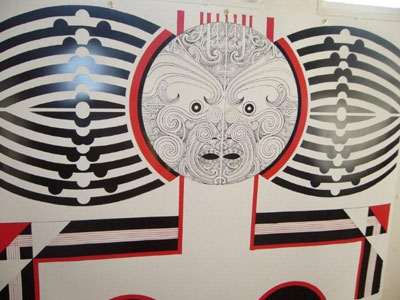
Para Matchitt's Te Tumaki
Next on the agenda was the Maori Celtic Art Auction, once again full of fabulous work by both well known and not so well known artists. Chris Tremain played the auctioneer role and works by Martin Popplewell, Jacob Scot, Para Matchitt and Dick Frizzell had the total sales at double the value of last year. Once again the Mad Butcher supported us strongly – goddam he must have a gallery of his own now.
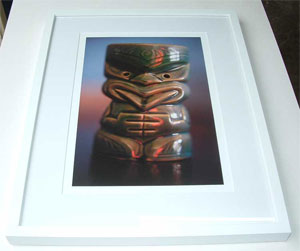
Aromatherapy Tiki by Brian Culy Bought by the Mad Butcher at the Maori Celtic Art Auction, courtesy of the Waiohiki Arts Village website.
Mark Sainsbury proposed the St Patrick’s Day Toast, coined by Hone Tuwhare, (Kia ora begorrah!) and then we were into a fresh stint of storytelling with Mike O’Donnell who gifted the audience with his spiritual journey named ‘Whakapapa of a White Man’. This took place in a darkened auditorium. O’Donnell provided a simple set, a thin white linen sheet decorated with koru type runes hung in front of a thicker sheet of linen – the ‘old people’s cloth’ as he called it. He projected images of clayworks he has made and scenes from the New Zealand bush onto the front sheet whilst he stood behind it, but in front of the back sheet, as he talked or played the flute. The auditorium was lit only by candles and the light from the projected images so that after a short while, even though we could see hints of him, the sonorous voice of the storyteller became the dominant feature. O’Donnell moved from his New Zealand experiences with Maori (mainly in the Hauraki area) and the learnings shared with him by kaumatua and kuia and his experiences walking around the land of his ancestors in Ireland and meeting the elders there. He talked of semiotics, the icons and symbols that seem to be shared between the Polynesian and the Gael. He pointed out similar fables and myths, similar language and words, and replicate values and spiritual paradigms. It was evocative, moving, beautiful and very intense. That St Patrick’s Day eve, at Waiohiki, Michael O’Donnell, storyteller, touched many listeners in the heart and pressed into their hands the keys to the gate of their soul.
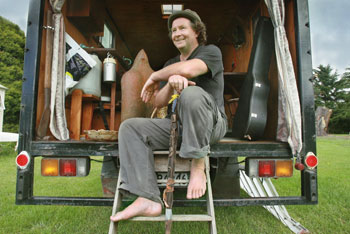
Michael O'Donnell, storyteller Courtesy of Hawke's Bay Today
And then, the next morning, we set up for the Irish Maori Golf Tournament at the Waiohiki Links. I have told you before of how Kurupo Tareha went to Queen Victoria’s 60th knees-up in England in 1896 and was taken up to Royal St Andrews where he played golf. He came home and turned his farm into a golf links and then went out and won the 1903 Open, and his son Kapi won the same event in 1913. We had wanted to use the excuse of St Paddy’s Day to re-engage some of the local Maori youth with golf. Basically the tough economic times of the 1980’s put golf club fees out of reach for most whanau and now there is a generational gap in players at the local (whanau) links. Anyway the troops turned up turned out in green, and onto the greens they went. So that was Paddy’s Day, this year more work than play from my perspective, and not one whiskey consumed!
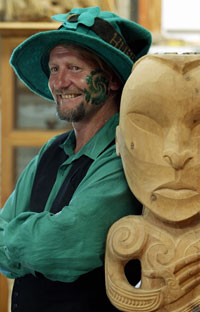
Leprochaun and friend
Rust never sleeps. Easter came hurtling up and with it two fresh events I needed to play a role in. One was our annual Easter Arts Market at the Waiohiki Creative Arts Village. The other was a hui of the Black Power at nearby Moteo Pa staring Good Friday, and, in the meantime, as explained I also had to cover the show in Wellington. The Black Power lads started trucking into Hawke’s Bay from all over the country late Friday afternoon. The hau kainga at Moteo (both Pa, Timi Kara and Hamuera were involved) had discussed their coming and had decided to take the manuhiri as they came, colours, patches, the good with the bad. The style of these Black Power events has changed profoundly as compared to the 1970’s and 80’s. These-a-days they are family events with a mix of meetings and sports as well as, of course, some partying. Additionally the tikanga is strong. The young leaders are well trained and speak Maori fluently, maintaining the dignity of their own ancestors as well as paying respect to the locals. I suppose there would have been about 500 Blacks and their whanau at the powhiri on the Friday.
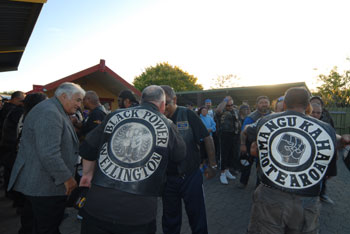
Nga Mihi
By the time of the sports on the Saturday, netball and then rugby league, played at Puketapu School there would have been about 1,500 spectators. On the road to the marae the Police had set up road blocks for drunk drivers and to curb expected misbehaviour. There were no driving drunks and in fact not one arrest over the entire weekend. I can’t tell you the detail of the korero but I can truthfully say that the discussions held during the hui were positive and pro-social. I can also tell you that Moana Jackson had the Black Power leadership, men and women, thinking very seriously about the things they need to do to express their tino rangatiratanga in a meaningful way. I sense the seeds sown by Paulo Friere in his visits here some thirty years ago are germinating.
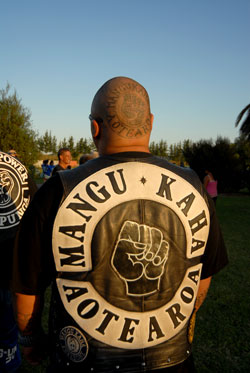
Take off your patch
On the Saturday evening, after the sports and a huge celebratory meal there was a presentation of trophies for the day’s sporting. The ‘”Fat Boy” and the “Huia”, two local trophies, one for league and the other for netball, were brought out for the first time in a decade. On their presentation the hau kainga, the people of Moteo village and areas close by, came forward and, led by Hoani Hawaikirangi, of Waiohiki, sang a special and beautiful local song that evoked local memories and made each person feel close to each other, united in a moment of love and mutual commitment. In Maori this is called whakawhanaungatanga.
So here’s the type of challenge I face on a regular basis. In the same day I’m the chairman of a community arts venture that’s running a gig at one end of the cultural spectrum, an arts fair with mainly Pakeha people, and, at the other, I’m contemporaneously culturally and professionally compelled to help close up a gang hui at another venue, appropriately, and in the traditional Maori way. The neat thing about time is that you can figure out where your effort will make most impact and the neat thing about a patch is that you can slip it over whatever else you are wearing. I dressed for my arts village commitments, dropping in at Waiohiki first to give affirmation to a team that had the job well in hand in any case, then donning my patch for my duties at Moteo. ‘Have you been for a round of golf bro?’ was the first greeting on arrival and this simple observation advised me that I had not achieved the chameleon like persona I may have intended.
I suppose we all get to a certain age where there is a dissonance between how we see ourselves and how we are seen by others. Dressed for golf and wearing a patch is another of those harbingers that tells me that my job for the Black Power, in the way I’ve been doing it, is near done. I reckon that there is a new wave of leaders abroad. I’m proud as punch of them and quite happy to get out of the fucking way! The paepae looks warm and beckoning.
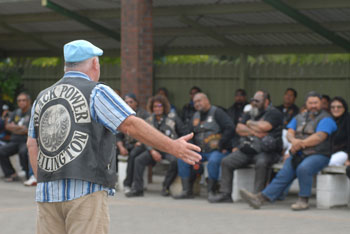
Paepae chameleon
Well we said goodbye to each other at Moteo. I think everyone involved with the hui has come out with a good buzz. The hapu Ngati Hinepare, Ngati Mahu, Ngai Tawhiao, have been respected and their mana has been upheld. In fact it may have been augmented. When kaumatua and kuia stand by our young people a certain form of grounding takes place. You see, during this hui people that our younger children and grandchildren have only known as names or distant figures stood by them in the face of, and against, popular opinion. Kaumatua Bill Prentice and Te Maari Joe will always get an extra degree of respect from me because of the leadership role they played over this Easter weekend. And I know that, in general, for the local younger brothers and sisters that ‘uncle Reka’ and ‘uncle Gilbert’ will forever be allowed to give directions and will be obeyed. The older ones built our respect for these blokes by playing rugby league alongside them. At Easter the younger ones saw their uncles carrying out those essential marae functions for the manuhiri and modelling Kahungunutanga. It was acculturating, it was socialising and it was developmental.
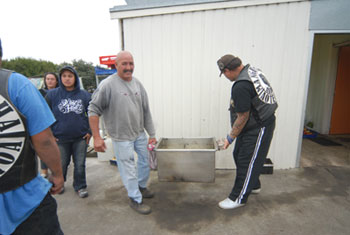
Uncle Reka
So, now its patch off, back to the arts village, and then, after checking out that all’s ok, off to Ruatoria to pick up on the Rasta story with which we started off the blog. On Friday I had scared the shit out of the journo/researcher Geoff Neems by directing him, if I wasn’t at home at Waiohiki, to hook up with me at Moteo. I had left several hundred patch members out of the equation, and he, being a skinny Pakeha, and a paranoid journalist to boot, felt a bit intimidated on arrival. Anyway after a night at our place and a comforting talk with Taape I hooked him up with Tama Kerika who at one stage was a Mongrel Mob president then became the leader of the Rastafarian bretheren called Te Rau Aroha. Tama is now back with the Mob and he holds a fascinating story of that period 1975-1980. Geoff by now had trucked on through to Gisborne to talk with Hugh Lynn of Eden Security, Paul Dainty, Warrior Records and Herbs fame. I agreed to meet up with Geoff at Hugh’s place so I grabbed my nephew Q and headed off. Q has come to Waiohiki via Spain. He is an O’Reilly, my side of the whanau. At times he has been described as mini-me, and it is true we have certain mutual proclivities around the drink. We meet up with Geoff in Gisborne on Sunday afternoon and all travelled through to Ruatoria to meet with John. It has been a while since I have been exposed to the deep learning of these East Coast Rasta. The conversations – “reasoning” – are long and deep. Having spent a little time in Jamaica and possibly having been the first Kiwi to hook up with the Ethiopian Federation in London I can tell you with some authority that these guys have a unique cut on Rasta. The point of conflation is that Haile Selaisse is the Second Coming. Apart from that the doctrine essentially flows from Ringatu although it is often couched in Rastaspeak.
There is a long and involved story here and I won’t do it disservice by cramming it in today, but there are some issues of interest worth noting. Firstly, it was Tigi Ness, imprisoned for his part in defying the Springbok Tour, that brought John Heeney into his understanding of and interest in Rasta. Then there was the fact that Bob Marley used the same scriptural quotes as the Ringatu kaumatua used in their contemplations that raised further interest. We talked of the hard days, the times when we probably came close to what could be called civil war within Aotearoa albeit within a very limited geography. I learned of Chris Campbell’s instruction that guns were not to be used – rightly concluding that all this would have resulted in would be the brethren being shot by superior armed forces.
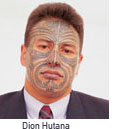 The asymmetric warfare these guys engaged in was cutting fences, rustling horses and of course, use of the ‘cleansing hand’ of fire. I thought of my friend and whanau Dion Hutana, and then of Diesel Dick Maxwell, at who’s tangi I had asked of him one last favour. “Take all of the shit with you please brother. Let everyone here place their grief in the waka with Dickie. Give every hara or wrong that comes between you and give it to the brother so he can take it away for ever.” It brought back memories to me of arguing with senior policemen about the way in which they were approaching the issues around Ngati Dread and of the counter-productive outcomes of trying to bash and intimidate these guys into submission. It reminded me that at the time no one was prepared to listen to these guys, generally because what they had to so was so challenging. On one hand it was seen to be the dope-addled ravings of a bizarre sect, and on the other seen to be, so true, and the follow on from Te Kooti. Times have changed. At that time was someone who may have been a bully vigilante might now be the ‘men against violence’ co-ordinator. And, just as ironically, John Heeney is now a volunteer fireman, still, in his words, prepared to put his life on the line for his community. The following morning we were outside John’s place preparing to leave. My nephew Q who wanders where angels fear to tread sees a young guy, about 18 or so, leading a horse up the road. Q goes over and starts chatting. I see him patting the horse then moving around towards the saddle. I know he has a crook back and my internal voiced is going “No Q, surely not”. He mounts, and, as if in a slowed down movie the horse bucks and he summersaults in the air and lands flat on his arse. The conversation had gone like this.
The asymmetric warfare these guys engaged in was cutting fences, rustling horses and of course, use of the ‘cleansing hand’ of fire. I thought of my friend and whanau Dion Hutana, and then of Diesel Dick Maxwell, at who’s tangi I had asked of him one last favour. “Take all of the shit with you please brother. Let everyone here place their grief in the waka with Dickie. Give every hara or wrong that comes between you and give it to the brother so he can take it away for ever.” It brought back memories to me of arguing with senior policemen about the way in which they were approaching the issues around Ngati Dread and of the counter-productive outcomes of trying to bash and intimidate these guys into submission. It reminded me that at the time no one was prepared to listen to these guys, generally because what they had to so was so challenging. On one hand it was seen to be the dope-addled ravings of a bizarre sect, and on the other seen to be, so true, and the follow on from Te Kooti. Times have changed. At that time was someone who may have been a bully vigilante might now be the ‘men against violence’ co-ordinator. And, just as ironically, John Heeney is now a volunteer fireman, still, in his words, prepared to put his life on the line for his community. The following morning we were outside John’s place preparing to leave. My nephew Q who wanders where angels fear to tread sees a young guy, about 18 or so, leading a horse up the road. Q goes over and starts chatting. I see him patting the horse then moving around towards the saddle. I know he has a crook back and my internal voiced is going “No Q, surely not”. He mounts, and, as if in a slowed down movie the horse bucks and he summersaults in the air and lands flat on his arse. The conversation had gone like this.
| Q: | “Mind if I ride your horse bro?” |
| Young Maori Fulla: (YMF) |
“Sure, bro”…pause…”I only broke him in yesterday” |
The significance of this comment passed the nephew by. It was surely grist to the mill of East Coast humour, and the story of the Pakeha guy who didn’t listen will light up many smiles as YMF recounts the tale in days to come. As with all comment from the edge, those that have ears to hear, let them hear.
Arohanui.








